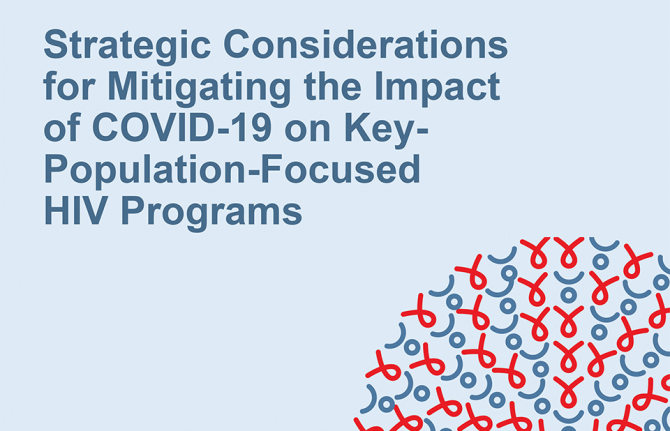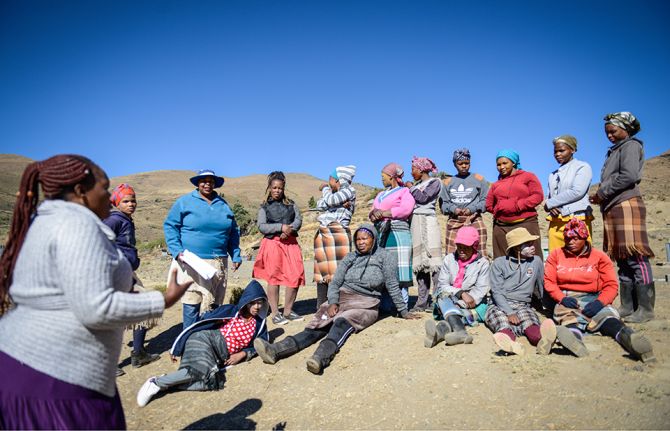

Feature Story
Mitigating the impact of COVID-19 on key populations
04 June 2020
04 June 2020 04 June 2020The COVID-19 pandemic has affected everyone, including key populations at higher risk of HIV. And the gains made against other infectious diseases, including HIV, are at risk of being reversed as a result of disruptions caused by COVID-19. This is the background to a new report published by FHI 360, in collaboration with UNAIDS and the World Health Organization (WHO), which gives advice on how to minimize the impacts of COVID-19 on key populations.
“With a focus on key populations, this guidance complements ongoing efforts to sustain access to HIV prevention services and commodities, sexual health and family planning services, prevention of gender-based violence and HIV counselling, testing and treatment during the COVID-19 pandemic,” said Paula Munderi, Coordinator of the Global HIV Prevention Coalition at UNAIDS. “Preserving essential HIV services for key populations and promoting the safety and well-being of staff and community members during the COVID-19 pandemic is vital to maintaining the hard-fought gains of the AIDS response.”
With practical guidance on how to support the continuation of HIV services for people living with HIV and key populations, the report is aimed at helping the implementers of programmes to carry on their work.
“Key populations are particularly vulnerable to HIV service interruptions and additional harm during the COVID-19 pandemic. We urgently require rights-based solutions that maintain or increase key populations’ access to HIV services while minimizing potential exposure to COVID-19 and promoting individuals’ safety. These must support physical distancing and decongestion of health facilities, but in ways that respond to the current realities of key populations,” said Rose Wilcher, from FHI 360.
The report gives practical suggestions in three main areas.
The first is on protecting providers and community members from COVID-19. HIV services can only continue to be provided during the COVID-19 pandemic if steps are taken to prevent coronavirus infection among programme staff, providers and beneficiaries. Links to COVID-19-related screening and care, and services to support the mental well-being of providers and beneficiaries, can also be given as part of HIV services.
The second area is supporting safe and sustained access to HIV services and commodities. HIV programmes can integrate physical distancing measures, offer virtual consultations and give multimonth dispensing of HIV medicines. Physical peer outreach should be continued where possible.
Monitoring service continuity and improving outcomes is the third area covered by the report. Since there are likely to be service disruptions, HIV programmes will need to adjust their monitoring and evaluation systems in order to allow for regular assessments of continued HIV service delivery and of the impact of COVID-19 on HIV programmes and their beneficiaries. This may require setting up strategic information systems that use physical distancing measures such as virtual data collection and reporting tools.
“The COVID-19 pandemic shouldn’t be used as an excuse to slow momentum in the global response to HIV among key populations. Instead, the pandemic is a time to draw lessons from our work to end AIDS. It is also an opportunity to provide relief to health systems overstretched by COVID-19 by fully funding community-based organizations led by gay and bisexual men, people who use drugs, sex workers and transgender people to ensure improved access to HIV services for key populations,” said George Ayala, Executive Officer of MPact.
“It remains critical to ensure access to HIV prevention, testing and treatment services during COVID-19 and sustain access to life-saving services. This document provides practical guidance and know-how on maintaining essential health services for key populations in these challenging times,” said Annette Verster, the technical lead on key populations at the WHO Department of HIV, Hepatitis and STIs.
The report was developed by FHI 360 as part of the Meeting Targets and Maintaining Epidemic Control (EpiC) project, which is supported by USAID and the United States President’s Emergency Plan for AIDS Relief. UNAIDS, WHO, the Global Fund to Fight AIDS, Tuberculosis and Malaria and partners gave inputs and advice.
Related resources
FHI 360: Five strategies for preserving key population-focused HIV programmes in the era of COVID-19
Global HIV Prevention Coalition
Rights in the time of COVID-19 — Lessons from HIV for an effective, community-led response
Lessons from HIV prevention for preventing COVID-19 in low- and middle-income countries
Condoms and lubricants in the time of COVID-19
Maintaining and prioritizing HIV prevention services in the time of COVID-19



